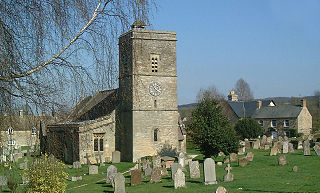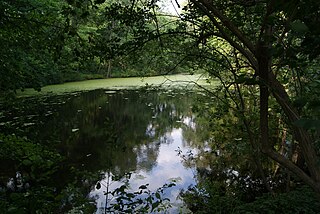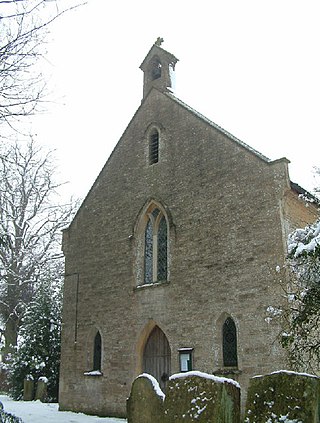
Edward Hyde, 3rd Earl of Clarendon, styled Viscount Cornbury between 1674 and 1709, was an English aristocrat and politician. Better known by his noble title Lord Cornbury, he was propelled into the forefront of English politics when he and part of his army defected from the Catholic King James II to support the newly arrived Protestant contender, William III of Orange. These actions were part of the beginning of the Glorious Revolution of 1688. Cornbury's choice to support his cousin Anne instead of William after the rebellion cost him his military commission. However, Cornbury's support of King William's reign eventually earned him the governorship of the provinces of New York and New Jersey; he served between 1701 and 1708.

Baron Churchill, of Wychwood in the County of Oxford, is a title in the Peerage of the United Kingdom and held by a branch of the Spencer family. It was created in 1815 for Lord Francis Spencer, younger son of the 4th Duke of Marlborough. He had previously represented Oxfordshire in Parliament.

The Cotswold Line is an 86+1⁄2-mile (139.2 km) railway line between Oxford and Hereford in England.

Wychwood or Wychwood Forest is a 501.7-hectare (1,240-acre) biological Site of Special Scientific Interest north of Witney in Oxfordshire. It is also a Nature Conservation Review site, Grade 1, and an area of 263.4 hectares is a national nature reserve The site contains a long barrow dating to the Neolithic period, which is a scheduled monument.

Savernake Forest stands on a Cretaceous chalk plateau between Marlborough and Great Bedwyn in Wiltshire, England. Its area is approximately 4,500 acres.

Ascott-under-Wychwood is a village and civil parish in the Evenlode valley about 4.5 miles (7 km) south of Chipping Norton, Oxfordshire, England. The 2011 Census recorded the parish's population as 560.

Milton-under-Wychwood is an English village and civil parish about 4 miles (6.4 km) north of Burford, Oxfordshire, just off the A361 road between Burford and Chipping Norton. The 2011 Census recorded the parish's population as 1,648.

Shipton-under-Wychwood is a village and civil parish in the Evenlode valley about 4 miles (6.4 km) north of Burford, in the West Oxfordshire district, in the county of Oxfordshire, England. The village is one of three named after the ancient forest of Wychwood. The others are Milton-under-Wychwood immediately to the west of the village and Ascott-under-Wychwood about 1.5 miles (2.4 km) to the east. The 2011 Census recorded Shipton-under-Wychwood's parish population as 1,244.

Herbert Robin Cayzer, 3rd Baron Rotherwick, is a British landowner and estate manager. He sat as a hereditary peer in the House of Lords for the Conservative Party, from 1996 until his retirement in 2022.

Glympton is a village and civil parish on the River Glyme about 3 miles (5 km) north of Woodstock, Oxfordshire. The 2001 Census recorded the parish's population as 80. The village and church are owned by the Glympton Park estate.

Wychwood Park is a neighbourhood enclave and private community in Toronto, Ontario, Canada. It is located west of Bathurst Street on the north side of Davenport Road, within the larger area of Bracondale Hill. It is considered part of the overall Wychwood official neighbourhood as designated by the City of Toronto.

Heythrop Park is a Grade II* listed early 18th-century country house 1 mile (1.6 km) southeast of Heythrop in Oxfordshire. It was designed by the architect Thomas Archer in the Baroque style for Charles Talbot, 1st Duke of Shrewsbury. A fire in 1831 destroyed the original interior. From 1922 until 1970 Heythrop housed first a Jesuit tertiary education college, and later a training establishment. The house is now the main building of the Heythrop Park Hotel, Golf & Country Club.

Finstock is a village and civil parish about 2 miles (3 km) south of Charlbury in Oxfordshire, England. The parish is bounded to the northeast by the River Evenlode, to the southeast partly by the course of Akeman Street Roman road, and on other sides by field boundaries. The 2011 Census recorded the parish's population as 797. For most of its history Finstock was a township of the ancient parish of Charlbury. Finstock became a separate civil parish in the late 19th century.
The Oxfordshire Way is a long-distance walk in Oxfordshire, England, with 6 miles in Gloucestershire and very short sections in Buckinghamshire. The path links with the Heart of England Way and the Thames Path.
Admiral of the White Hugh Pigot, of Wychwood Forest in Oxfordshire, was a Royal Navy officer. He commanded York at the reduction of Louisbourg in June 1758 and commanded Royal William at the capture of Quebec in September 1759 during the Seven Years' War. He went on to serve as Commander-in-Chief of the Leeward Islands Station during the American Revolutionary War and then became First Naval Lord. He also served as a Member of Parliament.
Charlbury Museum is a local museum in the town of Charlbury, Oxfordshire, England. The museum and collections are organized and run by the Charlbury Society, which was founded in 1949.

Cornbury Park is an estate near Charlbury, Oxfordshire. It comprises about 5,000 acres (2,000 ha), mostly farmland and woods, including a remnant of the Wychwood Forest, and was the original venue for the Cornbury Music Festival and later the Wilderness Festival.

Midwinter: Certain travellers in old England is a 1923 historical novel by the Scottish author John Buchan. It is set during the Jacobite rising of 1745, when an army of Scottish highlanders seeking to place Charles Stuart onto the English throne advanced into England as far South as Derby. The Prince, otherwise known as "Bonnie Prince Charlie", the grandson of the ousted King James II, required men and money from English Jacobite sympathisers, and the novel imagines why those were not forthcoming from landowners in the Western counties and Wales. It purports to sheds light on Samuel Johnson's previously unknown activities during that period.
Sir Thomas Brydges was an English landowner, a royal office holder and MP for Oxfordshire in first parliament of Elizabeth I.
Wychwood, or Wychwood Forest, is an area in rural Oxfordshire, England.
















